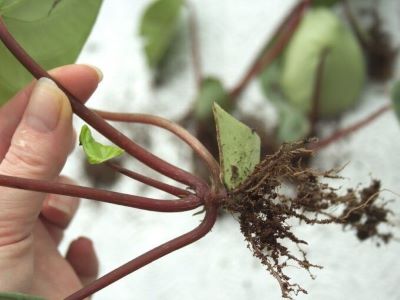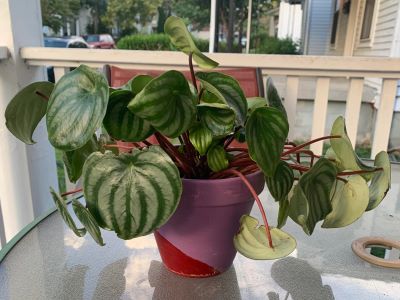Are you looking for a low-maintenance, easy-to-grow, and beautiful houseplant? Do you love the refreshing and juicy look of watermelons? If you answered yes to both questions, then you might want to consider adding a watermelon peperomia to your indoor garden.
Watermelon peperomia, also known as Peperomia argyreia, is a tropical plant native to South America. It has round, fleshy leaves that resemble the rind of a watermelon, with dark green and silver stripes. Plus, it can grow up to 8 inches tall and wide, making it perfect for small spaces and containers.
For your information, we have done some good research on care tips for your watermelon peperomia. We will also share some tips and tricks to keep your plant healthy and happy.
By the end of this guide, you will be ready to enjoy the sweet beauty of your watermelon peperomia.
Contents
Essential Care Tips for Watermelon Peperomia
Watermelon peperomia is an evergreen perennial in the genus Peperomia and the family Piperaceae. It is native to northern South America, including Bolivia, Brazil, Ecuador, and Venezuela. The plant is not closely related to either watermelons or begonias.
Furthermore, it has oval green leaves with silvery or cream-colored curved stripes. The leaves have a waxy feel, similar to some types of succulents. Plus, this plant produces green flower spikes on slim stalks, but the flowers are insignificant and hardly noticeable.

Well, it is easy to care for and grow as a houseplant, but only if you are a responsible plant parent. For your reference, we have jotted down some tips on how to provide the best conditions for your watermelon peperomia. Let’s dive in to know in detail.
1. Light
It prefers bright to medium indirect light, as direct sunlight can burn its delicate leaves. Place your plant near a window that receives filtered or diffused light. For instance, the north or east-facing window is the ideal place. Furthermore, avoid placing your plant in a dark or shady spot, as this will make it lose its vibrant colors and grow leggy.
2. Soil
Just like other plants need good quality soil, your peperomia also need the best one to grow happily. So, in that case, we recommend you use a standard potting mix for houseplants. Or make your own by mixing equal parts of perlite, compost, and peat moss or coco coir.
Note: Keep in mind, do not use a soil mix that is too heavy or dense, as this can cause root rot and fungal infections.
💡Why monstera leaves drooping?
3. Water
Watermelon peperomia likes to be watered regularly, but not too frequently. The best way to water your plant is to let the top 1-2 inches of the soil dry out between watering, and then water thoroughly until the excess water drains out of the bottom of the pot. Remember not to leave your plant in water for too long because it can cause root rot and other problems.

Note: Water your plant less often in winter, when the growth slows down.
4. Temperature and Humidity
As we have an idea, this plant thrives well in warm and slightly humid environments, similar to its native rainforest habitat. So, the ideal temperature range for this plant is between 60°F and 80°F (17°C – 27°C). Also, avoid exposing your plant to temperatures below 50°F (10°C), as this can cause leaf damage and wilting.
Note: To increase the humidity around your plant, you can mist the leaves occasionally. For that, you need to place them on a tray of pebbles and water or use a humidifier.
5. Good Fertilizer for Watermelon Peperomia
Watermelon peperomia does not need a lot of fertilizer, but it can benefit from some feeding during the growing season. For that, you can use a balanced liquid fertilizer diluted to half strength once a month from spring to summer. However, we suggest you do not fertilize your plant in winter when it is dormant. Plus, avoid over-fertilizing your plant, as this can cause leaf burn and nutrient imbalance.
Steps to Propagate Watermelon Peperomia
Ah! Propagating watermelon peperomia is not difficult, but it requires some specific steps to ensure success. No worries, in this following section, you will get to know two methods to propagate your watermelon peperomia. Let’s get started!
Firstly, you need to have the following tools for the propagation method:
- Healthy watermelon peperomia plant
- Sharp knife or scissors
- Pot with moist and well-draining potting mix
- Glass dome or a plastic bag
1. Leaf Cutting Method:
First, you need to identify a healthy and mature leaf from the mother plant. Now, cut the leaf with a short stem attached, about 2 to 3 inches long. Then, cut the leaf in half horizontally, separating the top and the bottom parts. By doing this, you will notice that each part has a main vein running through it. This is where the roots will grow from. And don’t forget to keep track of which part is the top and which is the bottom.
Next, insert the cuttings into the potting mix, with the cut side facing down and the vein slightly exposed. You can fit several cuttings in one pot, but leave some space between them. Now, cover the pot with a glass dome or a plastic bag to create a humid environment. After that, you need to place the pot in a bright spot, but, avoid direct sunlight.
Water the cuttings lightly when the soil feels dry to the touch. After 3 to 4 weeks, you should see some roots and new leaves emerging from the cuttings.
Congratulations, you have successfully propagated watermelon peperomia by leaf cuttings!

2. Stem Cutting Method:
Take a healthy and long stem from the mother plant. After that, cut the stem with at least 3 to 4 leaves attached, and remove the lower leaves. You can either place the stem cutting in a glass of water or insert it into the potting mix.
If you choose to use water, make sure to change it every few days to prevent rotting. Or, if you choose to use soil, you can cover the pot with a glass dome or a plastic bag to increase humidity.
The next step is to place the cutting in a bright spot. The watering routine is the same as the above method, then you need to wait for the roots to grow. Tentatively, after 3 to 4 weeks, you should see some roots growing from the stem.
You have successfully propagated watermelon peperomia by stem cuttings!
These are the two methods to propagate watermelon peperomia. You can select the one that suits you best, or try them all and compare the results.
Common Problems With Watermelon Peperomia
Watermelon peperomia may look like a slice of summer, but they are not immune to some common plant problems. Whether it’s pests, diseases, or environmental stress, these issues can affect the health and appearance of your watermelon peperomia. In this section, we will explore some of the most common problems with your peperomia and how to prevent and treat them.
By following these tips, you can ensure that your stunning indoor plants stay happy and healthy all year round.
1. Drooping Leaves
There are several possible causes for this issue, such as low humidity, incorrect watering, insufficient sunlight, or dusty leaves. Each of these factors can impact the plant’s ability to absorb water and nutrients, maintain turgor pressure, and perform photosynthesis. As a result, the leaves may lose their firmness and hang downwards.

If you wish to prevent or fix drooping leaves, then you will need to provide the optimal conditions for watermelon peperomia to thrive. For instance, water your plant when the top inch of soil feels dry, mist the leaves occasionally, place the plant in bright indirect light, and clean the leaves regularly.
By following these simple steps, you can enjoy the beauty of this easy-to-care-for houseplant
2. Watermelon Peperomia Leaves Curling
It is a popular houseplant with attractive watermelon-like foliage. However, sometimes you may notice that the leaves start to curl, which can indicate a problem with the plant’s health. There are several possible causes for watermelon peperomia leaves curling, such as underwatering, overwatering, low humidity, high temperature, poor light, water quality, or root rot. Each of these factors can affect the plant’s growth and development, as well as its ability to maintain its shape and structure.
3. Leaves Turning Brown
Watermelon peperomia (Peperomia argyreia) is a tropical plant with stunning watermelon-patterned foliage. But, just like other plants, this plant also suffers from some common problems, such as leaves turning brown. There are numerous possible causes for this issue, such as overwatering, underwatering, low humidity, sunburn, or pests.
To prevent or fix brown leaves on your watermelon peperomia, you need to provide the right growing conditions and care for this plant.
4. Yellow Leaves
It’s very common to encounter yellow leaf issues in plants, and watermelon peperomia is not an exceptional one. This plant can also suffer from yellowing leaves issues. It happens due to several issues, such as overwatering, underwatering, low light, nutrient deficiency, or pest infestation.
So, to prevent or fix yellow leaves on watermelon peperomia, you need to identify the root cause of the problem. For instance, provide bright indirect light. This is because these plants thrive in bright to medium indirect light, but not direct sunlight. As direct sunlight can scorch the leaves and make them turn yellow or brown. If your plant is in a low-light area, move it to a brighter spot or use artificial lighting.
This plant is easy to care for and grow as a houseplant, as long as you provide the right conditions and avoid common problems.
Read: Begonia maculata care; Rhaphidophora decursiva care guide!
FAQs
Why is my Watermelon Peperomia not growing?
There could be several reasons, such as insufficient light, overwatering, underwatering, low temperature, or poor soil quality. To encourage growth, ensure your plant gets bright, indirect light for at least 5 hours a day. Water it only when the top 1-2 inches of soil are dry. Please keep it in a warm and humid environment, and fertilize it monthly during the growing season.
Do Watermelon Peperomia like sun or shade?
Watermelon Peperomia prefers bright, indirect light or partial shade. They do not tolerate direct sun, especially in the afternoon, as it can burn their leaves and fade their colors. In addition, they can survive in lower light conditions, but their growth and appearance may suffer.
Can Watermelon Peperomia grow in water?
Yes, Watermelon Peperomia can grow in water, as long as you change the water regularly and add some liquid fertilizer occasionally. You can propagate Watermelon Peperomia by taking stem or leaf cuttings and placing them in water until they develop roots. Then you can either transfer them to soil or keep them in water.
Should I repot my watermelon peperomia?
Watermelon Peperomia does not need to be repotted often, as they like to be slightly root-bound. You should only repot your peperomia if the roots are visibly coming out of the drainage holes. Or if the soil is too compacted or depleted. When repotting, choose a pot that is only slightly larger than the previous one, and use a well-draining potting mix.

Hi, I’m Jacqueline, the editor-in-chief of cozynest. I have a passion for plants and gardening, also, have a degree in horticulture from the University of California, Davis. I love to share my knowledge and experience with our readers and help them create beautiful and healthy gardens, indoors, and outdoors. I also enjoy experimenting with different plant varieties, designs, and techniques, and learning from other experts in the field. When I’m not working on cozynest, you can find me in my own cozy nest, surrounded by my favorite plants and books.

